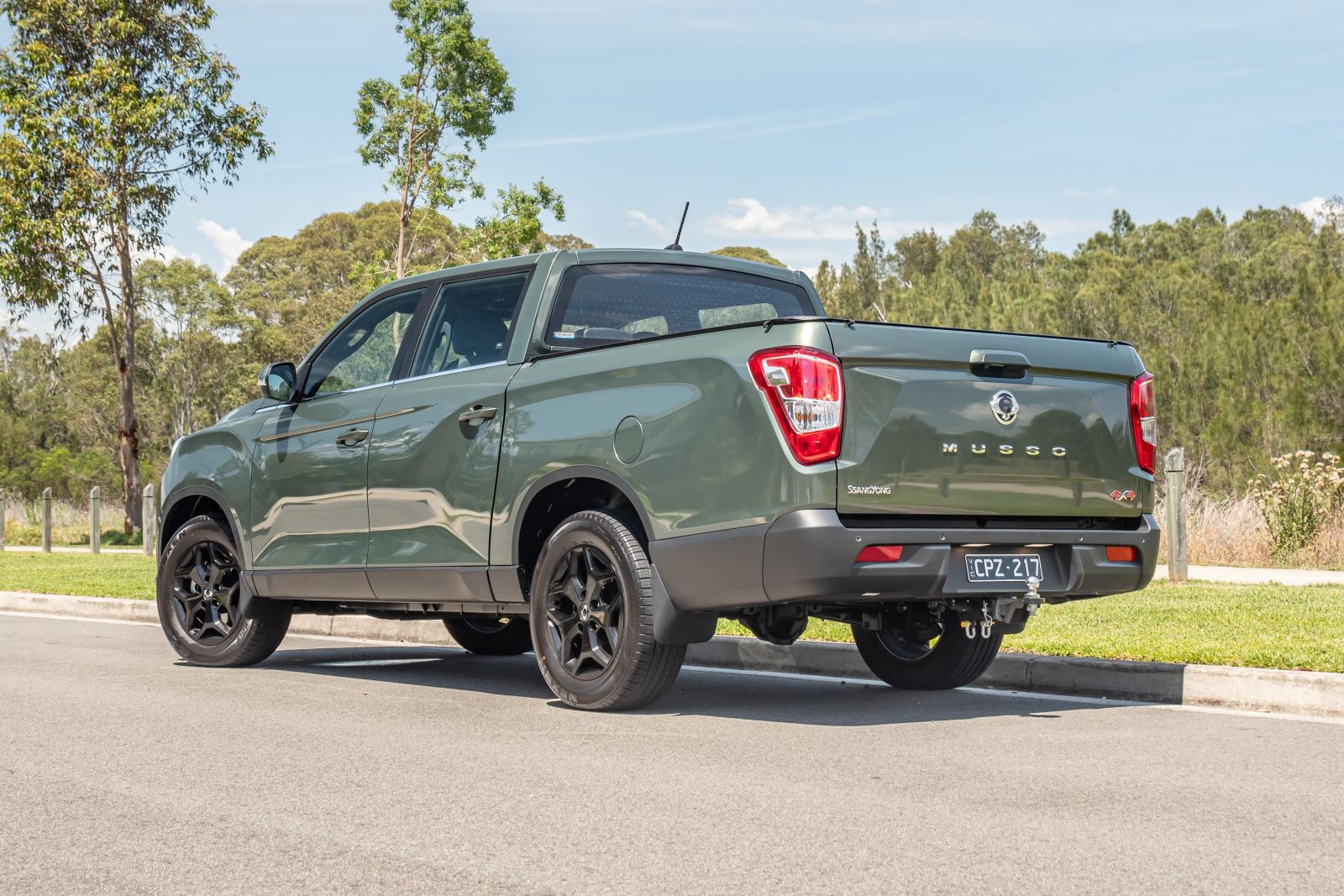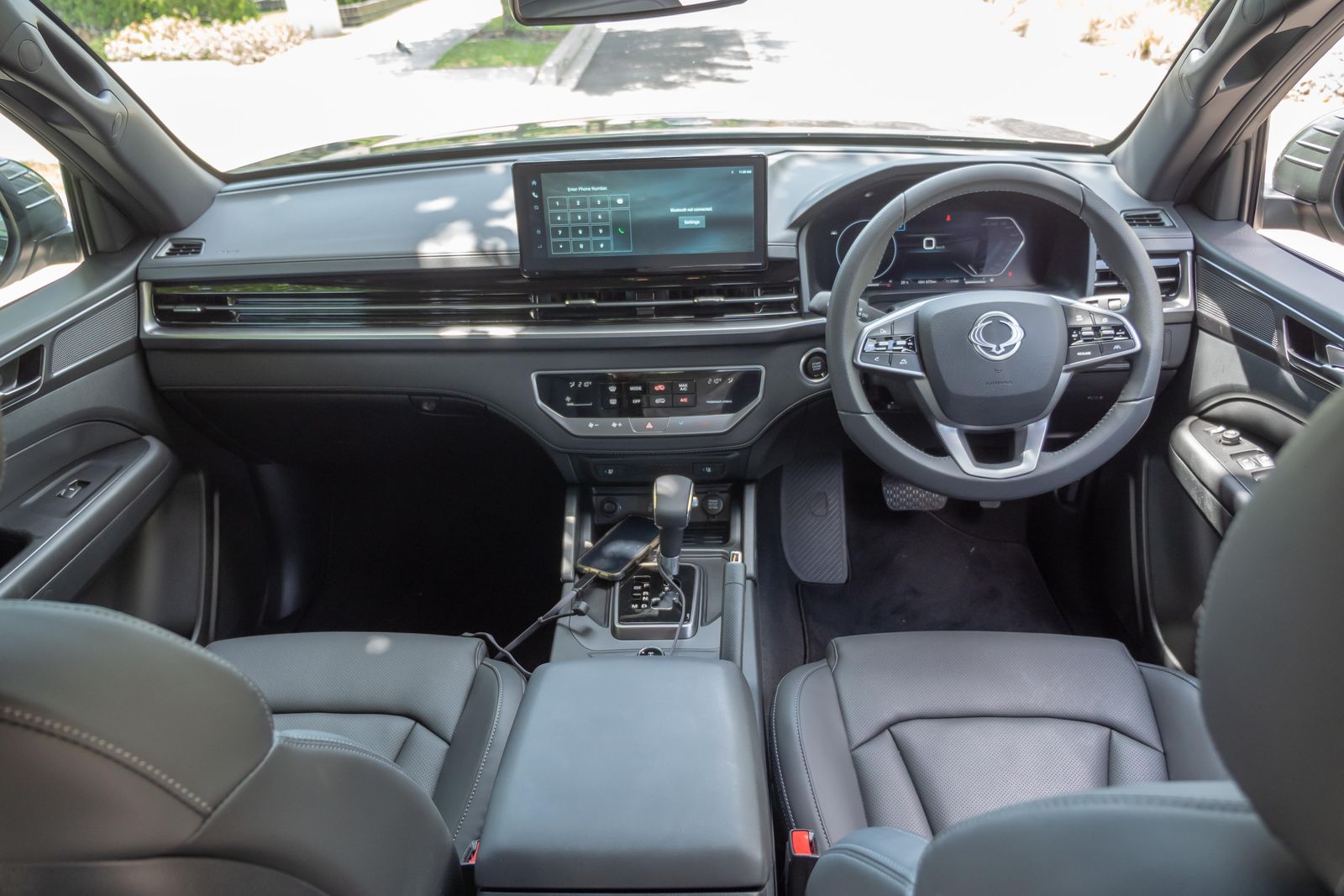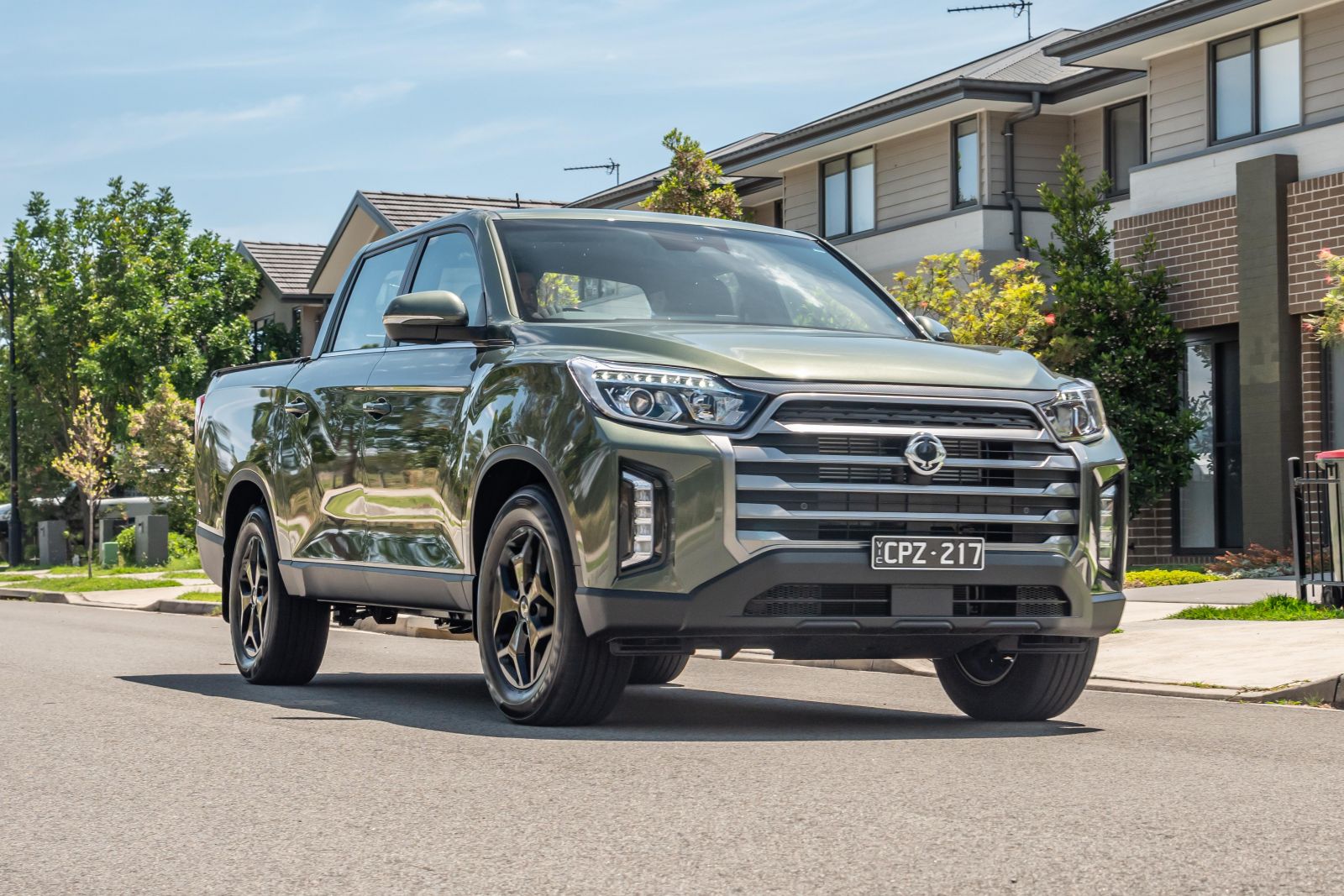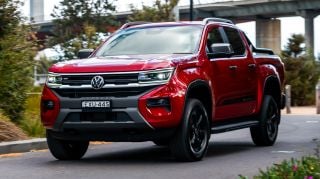The SsangYong Musso has been a surprise success story for the Korean brand in 2023, with record sales and a revamped model range sure to keep the momentum going.
This is the newly added Adventure model in the line-up, which splits the difference between the entry-level work-focused ELX and the more premium-priced and highly specified Ultimate model.
The Adventure looks a little different to the other grades, with black wheels setting it apart, but it doesn’t get the same level of overhaul for adventurous driving that you see in, say, a GWM XSR Ute.
But it is still an attractive thing based on the price and ownership promise; although, there are some potentially showstopping shortcomings that could rule it out for you – read on for more.
How much does the Ssangyong Musso XLV cost?
The updated Musso range is a bit pricier thanks to upgraded technology on offer. On test we have the new Adventure XLV, which is priced from $44,000 drive-away. See below for a full pricing breakdown for the updated range.
What’s the difference is between the standard Musso and the XLV? It’s short-wheelbase versus long-wheelbase, with the XLV scoring a stretched chassis and a longer tub, but the cabin is the same size.
For context, the pricing of the Musso is higher than the last version ($1210-$1910 depending on variant), and it’s a shame that the Musso brakes the $40,000 barrier as its starting point. That’s partly because the brand has dumped the manual gearbox option which was previously offered in the base ELX. The Musso also offers a bit more gear now though, which is detailed further down.
However, it isn’t as well equipped or as well priced as the value king in the budget ute segment, the GWM Ute. These kick off from just $35,990 drive-away for the base model dual-cab 2WD automatic. GWM also offers the choice of a pick-up or cab-chassis body style now, too. The 4WD versions start from $42,490 D/A.
The LDV T60 Max is the other budget ute you could be considering, and prices for ABN holders are quite sharp, starting from $34,990 drive-away for the base model dual-cab 4WD manual ute.
2024 SsangYong Musso pricing:
- SsangYong Musso ELX: $40,000
- SsangYong Musso ELX XLV: $41,500
- SsangYong Musso Adventure: $42,500
- SsangYong Musso Adventure XLV: $44,000
- SsangYong Musso Ultimate: $45,000
- SsangYong Musso Ultimate: $46,500
Prices are drive-away
What is the Ssangyong Musso XLV like on the inside?
If you’re upgrading from the previous model, or you sit between the two at the showroom, you’ll instantly see the difference that the big, twin 12.3-inch screens make to this cabin.
That’s not to say that the old version was feeling all that outdated – but the new one, with its bright and crisp infotainment display sitting proudly atop the dashboard and a colourful and info-rich screen in the instrument binnacle – just feels more modern and a bit more upmarket.
The new media screen isn’t without its foibles, though. It’s pretty basic if you ask anything more of it than to listen to the radio or mirror your phone, and I had a number of issues with Apple CarPlay while using this vehicle.
I switched cables a few times until one finally worked, and even then, you seemingly have to follow a set sequence (start the car THEN plug in your phone – not the other way around) for it to work.
There is also no wireless Apple CarPlay or Android Auto, there are no volume or tuning dials, and the glitchy nature of the display (it kept blanking out when I was using a different cable, and the only way it would reactivate was by adjusting the air-con or reversing) makes me wonder if this wasn’t an upgrade just for the sake of an upgrade.
The digital driver’s display; however, is a revelation. It has bright and clear instrumentation, a number of configurations and a depth of info available through the buttons on the steering wheel… which is also where you’ll find the only buttons for volume and tuning for the media screen, in case you’re wondering.
Now, the controls for the air-con are good. They’re not quite haptic jobbies as you find in some other models, but nor are the temperature and fan controls actually buttons. They are touch-sensitive toggles, and there’s also a bank of buttons there for your fan speed, air-con, mode and more.
Weirdly though, in our test car there was one temperature readout displaying, for example, 22.0 C, while the other was missing the decimal point, meaning it read 220 C. Thankfully it wasn’t pumping out human-melting heat!
In the Adventure and Ultimate models you also get a set of controls down below for your seat heating and cooling up front, and those are really great features in a ute at this kind of money. You can’t even get multi-stage seat heating in a Toyota HiLux, let alone cooling!
Right, so the practicalities of the cabin could be a little bit better. Sure, you’ve got a pair of cupholders, a covered centre console bin, bottle holders in the doors and a small loose item cubby in front of the gear selector, but you don’t get a large console bin or storage spot for your phone, and there’s no wireless phone charging, either.
Back seat space is adequate, but not as roomy as a GWM or LDV ute. With the driver’s seat set to my position (at 182cm/6’0”) I had my knees hard-up against the seatback, and it’s a hard plastic seatback, too.
This is good for parents because it won’t be easily destroyed by kids, but not so great to have your knees jammed into. Foot room and head room are good though, and you can fit three adults across the back.
But would you want to? I mean, the fitment of a centre lap-only seatbelt is a big safety oversight in my opinion. A three-point harness isn’t too much to ask for, surely?
There’s a light at the end of this tunnel; though, as the Musso is one of the only utes (maybe the only ute in this segment) with three – yes, 3 – top-tether points to attach child-seat straps too.
So, if you were to position a kid seat in the middle with just the lap-strap belt in play, you’d still be able to tether it in position using the middle top-tether. There are also ISOFIX points in the window seats.
The amenities are good in the second row, with a pair of directional air-vents, map pockets on both seatbacks, and bottle holders in both doors, plus – if you don’t plan to use that middle seat – you can fold down the armrest with cupholders instead.
Unlike some other utes, there is no flip-up seat base in the Musso, but there is a clever pull-out drawer accessory available in the parts catalogue, if you want to make it a bit more practical.
Speaking of practical, let’s talk about this tub – it’s the reason you’d choose the XLV model over the standard version, because you get a heap more tray space.
The standard tub is 1300mm long, measures 1570mm wide, 1140mm between the arches (meaning it’s a touch too narrow for the 1165mm Aussie square pallet), and has a more chasmic depth than most utes at 570mm.
Choosing the XLV will mean the same width, arch-gap and depth, but a huge 1625mm of floor tub length, meaning if you left the tailgate down you’d be able to fit two Euro pallets in, nose-to-tail, with ease.
Something you really ought to keep in mind with the Musso is that it’s a big thing if you buy the XLV. It’s rather oddly proportioned, too, with a stumpy nose, normal sized cabin and long tray, meaning you really need to keep an eye on your mirrors in parking lots and tight spots.
For reference, the regular Musso is a relatively tiny 5095mm long with a 3100mm wheelbase. Choosing the Musso XLV means you’re dealing with 5409mm of length and a 3310mm wheelbase.
Both are 1950mm wide, but there’s also a bit more height for the XLV, at 1855mm versus the still-totally-carpark-suitable 1840mm SWB model.
What’s under the bonnet?
The SsangYong Musso range is offered with one powertrain, but two states of tune.
The 2.2-litre four-cylinder turbo-diesel is good for 133kW of power, but torque varies between the SWB models (400Nm) and the LWB XLV versions (420Nm). This is partly to assist with the extra weight and capability that the XLV grades offer up.
All versions of the Musso have a six-speed Aisin automatic gearbox fitted, and selectable four-wheel drive (2H, 4H and low-range 4L) and an auto-locking rear differential, too.
Now, when it comes to the capability and capacity on offer here, in some ways it depends which model you pick, but in others, it doesn’t.
All grades come with an unbraked towing capacity of 750kg and a braked maximum towing capacity of 3500kg, which is the benchmark level for dual-cab utes. Then it gets interesting when it comes to the other numbers you need to know.
So, the gross vehicle mass (or GVM) for the SWB versions of the Musso is 2880kg, and that jumps to 2980kg for the XLV versions of the Adventure and Ultimate. But if you choose the ELX XLV model, the figure is 3220kg, because it has leaf-spring rear suspension, where the other versions are all running a rear coil-spring setup.
That has an impact on gross combination mass (GCM), too, with the SWB models rated to 6380kg, and the Adventure and Ultimate XLV long-wheelbase models pegged at 6480kg. But the ELX XLV has a huge GCM of 6720kg, which makes this thing properly suited for hard work.
Now, let’s consider payload capacity for the model range. All SWB versions have a payload of 790kg. And the XLV versions of the mid- and high-grade models are rated to 880kg. It’s only the ELX XLV that cracks a tonne (1010kg to be exact) of payload capacity – because of those leaf springs.
How does the Ssangyong Musso XLV drive?
The Musso drive experience is decent, but not groundbreaking.
As has been the case for a while now, the 2.2-litre turbo-diesel feels up to the task, with a decent amount of mid-range shove. It isn’t quick from a standstill, but it has enough punch to help you overtake without fuss, and feels comfortable and never underdone on the open road.
I didn’t do a load test or tow this time around, but I have done so in the past in the Musso XLV, and the engine seems to appreciate the hard work you throw at it.
The six-speed automatic transmission is also decent, with mostly smooth shifts in urban and open road situations. But I did have a few instances where the gearbox decided to shuffle back and forth needlessly at lower speeds, when it could have relied on the torque to pull through. Same at higher speeds, where it can be busier than it needs to.
The bigger high-speed concern; though, is the steering. In Adventure and Ultimate spec – there is a speed-sensitive steering system that alters the weighting of the steering, and makes it unnecessarily heavy when you turn the steering wheel at speeds around 80km/h to 110km/h.
It can catch you off-guard. It’s almost like losing power steering on the highway. Things just go hefty all of a sudden. It could do with some fine-tuning, and there are no drive modes to adjust the steering weight, either.
Also a little unsettling is the ride, which doesn’t quite nail the brief of being a work-and-play vehicle quite as well as some other budget utes. It still very much feels like a body-on-frame ute.
If you’re stepping out of a 20-year-old trade-in, you mightn’t pick up on the wobbly feel it exhibits over most bumps (at low and high speeds)… but if you’ve just driven a GWM Ute, you’ll feel like this is a bit of a backwards step.
Furthermore, I really wish there had been some changes made to the Adventure to make it look and feel a bit more adventurous. Different suspension, more aggressive tyres, or even a sports bar would have added something to this package.
Thankfully, at least the safety technology (which I’ll tell you more about soon) in this vehicle isn’t too overbearing.
There’s a lane departure warning system which doesn’t try and steer for you; it just beeps to tell you if you’re straying from your lane. It has a simple button to turn that off on the steering wheel, which you will want to do each time you drive.
And I noted there are some potential buyers who commented they wouldn’t choose a Musso because it still doesn’t have adaptive cruise control. It’s a good point, considering that system is offered in the ute’s home market of South Korea.
Funnily enough, that adaptive cruise system is integrated into an electric power steering set-up that also brings lane-keep assist and active lane centring – so is it really is a big shame we don’t get that tech…
What do you get?
Musso ELX highlights:
- 17-inch alloy wheels
- Full-size spare wheel
- Automatic high-beam
- LED daytime running lights
- Front fog lights
- Rain-sensing window wipers
- Heated side mirrors with integrated indicators
- Assisted tailgate operation
- 12.3-inch digital instrument cluster
- 12.3-inch touchscreen infotainment system
- Apple CarPlay, Android Auto
- 6-speaker sound system
- 2 x front USB-C ports
- Fabric upholstery
Musso Adventure adds:
- 18-inch black alloy wheels
- LED vertical front fog lights
- Speed-sensitive power steering
- Reach-adjustable steering wheel
- Leatherette upholstery
- Heated and ventilated front seats
- Tyre-pressure monitoring
Musso Ultimate adds:
- HID headlights
- Walk-up welcome system
- Touch-sensing front door locks
- Walk-away automatic door locking
- Heated steering wheel
- Blind-spot monitoring
- Rear cross-traffic alert
- Lane change-collision warning
- Safe Exit Warning
- Surround-view camera
Ultimate Luxury Pack ($3000) adds:
- Powered sunroof
- Premium leather upholstery
- Power front passenger seat
- Driver power lumbar support
- Heated outboard rear seats
Is the Ssangyong Musso XLV safe?
If you need a relevant automotive safety authority to convince you that a vehicle is safe, then you’re going to be disappointed here, as there is no ANCAP or Euro NCAP rating for the Musso.
Further to that, this vehicle has something that should, in my opinion, be outlawed in a new car – a lap-only centre seatbelt. I get it, if that’s what you’ve got to keep you safe in a 1970s Ford or Holden, that’s cool. But lap-sash seatbelts have been around since the 1950s!
Standard safety equipment includes:
- 6 airbags
- Autonomous emergency braking (AEB)
- Forward collision warning
- Lane departure warning
- Driver attention warning
- Reversing camera
- Front and rear parking sensors
Musso Ultimate adds:
- Blind-spot warning
- Rear cross-traffic alert
- Lane-change collision warning
- Safe Exit Warning
- Surround-view camera
I’m not a huge fan of the “richer people deserve to be safer” mindset, and sadly, if you’re willing and able to spend more on your Musso, you’ll get more safety equipment.
How much does the Ssangyong Musso XLV cost to run?
The Musso makes sense from an ownership point of view.
There’s a seven-year, unlimited kilometre warranty for private and business customers, and a seven-year roadside assistance plan on offer, too.
Servicing intervals are every 12 months/15,000km and – you guessed it – there’s a seven-year capped-price program that spans out to 105,000km, with the average maintenance fee capped at $375.
As for fuel consumption, the SWB models have an official fuel consumption rating of 8.6 litres per 100 kilometres on the combined cycle, while the XLV LWB models are pegged at 9.0L/100km.
In my testing, I saw a return of 9.9L/100km across a mix of driving, but there was no towing, off-roading or loaded testing as part of this drive.
CarExpert’s Take on the SsangYong Musso XLV
The SsangYong Musso’s changes might appeal to those who want a more high-tech look and feel inside their ute.
The value equation still stacks up for buyers on a budget who want a dual-cab diesel 4×4 and don’t want to wait 18 months to get it.
But while it is a decent thing, it falls a bit short of being great because as I’ve explained, there are some notable issues to consider – if it were me, I’d be getting into a GWM Ute instead.
Click the images for the full gallery
BUY: SsangYong Musso
MORE: Everything SsangYong Musso






























